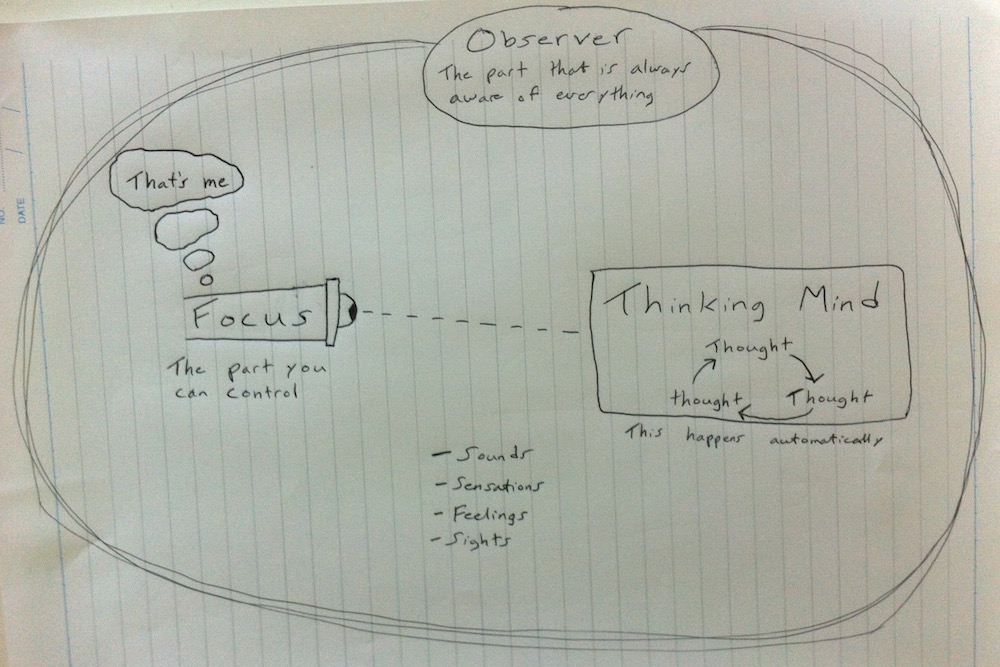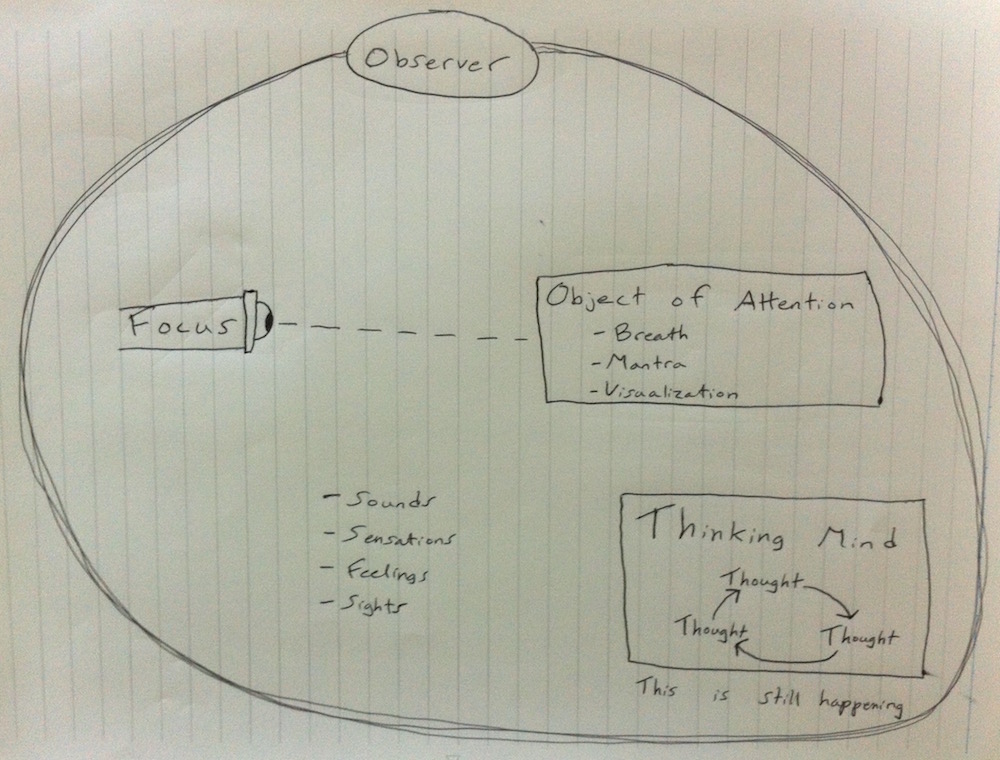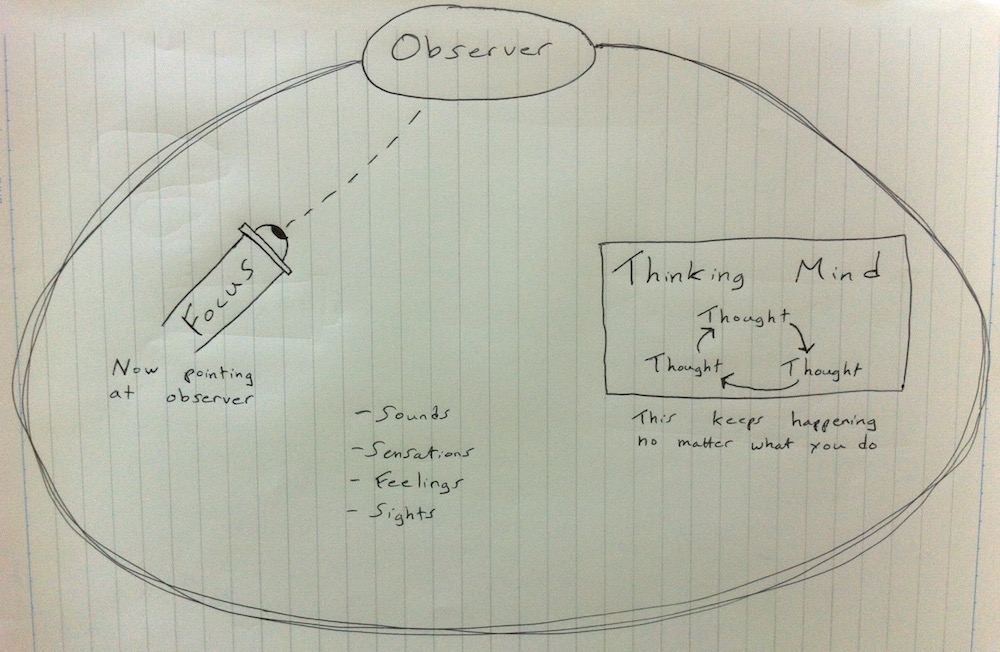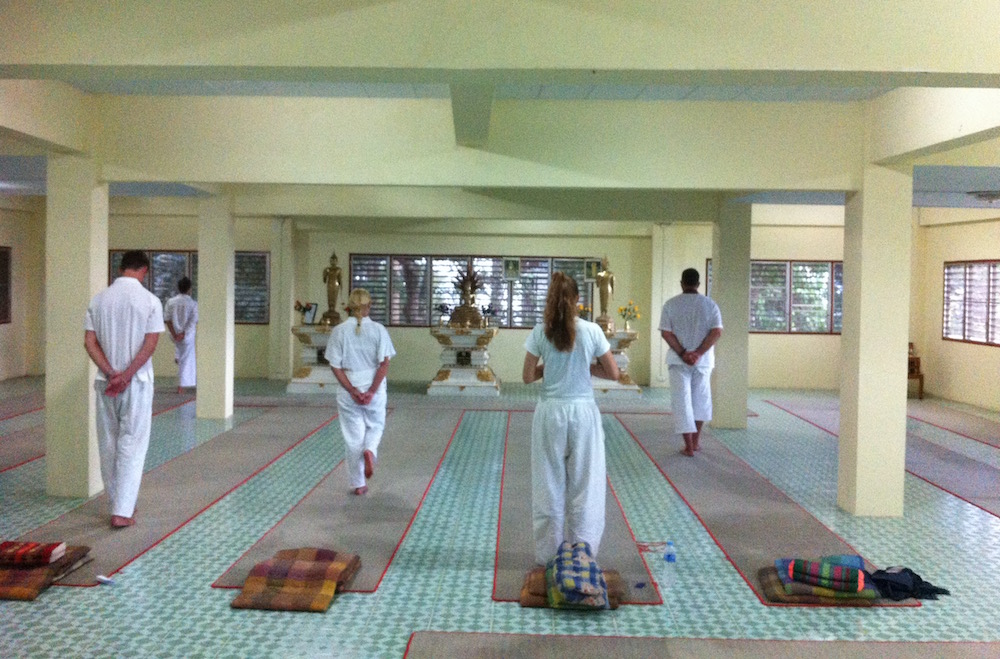Update: I don’t subscribe to these models anymore. Check out The Mind Illuminated for much better ones.
This post covers three broad meditation techniques for developing mindfulness and concentration.
To understand these techniques we’ll use a model of the mind and some pictures. In this context it can be helpful to look at the mind visually.
(There are of course other ways to think about the mind – but to explain these meditation techniques this model works pretty well.)
There are four elements of the mind in this model – one element that you are able to control and three that you are not.
Observer – This is the part of you that is always aware of everything at once. It is permanent, unchanging, and just “watching” what is happening with no input or commentary. The Observer is there from the day you’re born until the day you die – you can’t make it appear or disappear, it is just there.
Focus – This is the part of your mind that you can control. You can decide where to put your focus.
Thinking Mind – This is the part that generates an automatic stream of thought. It never stops thinking, thought after thought, all the time. The Thinking Mind is the source of all mental chatter and is also sometimes called the “Monkey Mind”.
Sounds, Sensations, Feelings, Sights – These are the other contents of your consciousness – all the other phenomena happening inside your field of awareness.
So using this model, the following is the state of most people’s minds, most of the time:

Focus is glued to the Thinking Mind and there is most likely little or no awareness of a distinction between the two. This person is identified with their thoughts and they believe they “are” their thoughts.
This is all unconscious, and this state of “thinking without knowing that we’re thinking” is the default for human beings. It’s the way we are most easily and naturally.
Meditation involves extricating oneself from the Thinking Mind and the endless stream of thoughts it produces. This is done by putting the focus on something other than the Thinking Mind.
So let’s look at 3 different meditation techniques –
Concentrative Meditation
Concentrative meditation involves choosing a single object of attention and keeping the Focus trained on it for the duration of the practice.
The purpose of this meditation technique is to develop what is called “single pointed concentration” “one pointed focus” or “one pointed attention”.
Common objects of attention are:
- The breath
- A mantra
- A visualization
The mind during concentrative meditation looks like this:

Focus works like a muscle – the more you train it, the stronger it gets – and concentrative meditation is an excellent tool for training this muscle.
While practicing this type of meditation you may become distracted by sounds, sensations or feelings – but most likely you’ll become distracted by the thoughts of the Thinking Mind.
That goes something like this:
Breathing in, breathing out…
Breathing in, breathing out…
Breathing in – Man, I really need to sell my fridge. I need to find someone to buy it – maybe I’ll post it on Facebook. What is it, a week until I leave? What else do I need to do before moving out? Maybe I’ll test pack my luggage to see if it all fits. What’s the weight limit is on the plane again…? Don’t want to get charged extra because the bag is too heavy. Flight’s at 8PM – should I try to sleep on the plane? What’s the time difference again –
And so on.
The challenge and the real core of the practice is to 1) realize you’ve become distracted and 2) return the focus to the object of attention.
It is both extremely simple and extremely difficult, and it is one of the most powerful meditation techniques that exist.
Open Awareness Meditation
This technique involves allowing everything to come and go through your awareness – sounds, feelings, thoughts, sensations – while maintaining an open and clear mind.
The mind during open awareness meditation looks like this:

Focus is trained on The Observer – that neutral part of the mind that is always there and just watching everything. In open awareness meditation it feels like you are “becoming” the Observer – the Focus is not intense and single-pointed but rather relaxes back into a complete openness.
Again most likely you will become distracted by thoughts – just notice you are thinking and go back to “being” the Observer.
Two Open Awareness Meditation Techniques
You can also do open awareness meditation with the eyes open, allowing sights or objects to move through your visual field the same way you let thoughts pass through the mind.
This is very challenging because visual cues very easily bring up thoughts and distract you from the practice – this is the main reason most meditation techniques (and especially for beginners) are taught with the eyes closed. The field of vision is a very potent potential distraction.
Another form of open awareness meditation is one I have written about before: the “headless way” or “having no head” technique.
The key here is to train the Focus on the feeling that this technique brings about – a feeling of detachment and spaciousness of mind or even “oneness”.
Try listening to this audio meditation. It’s either going to sound like complete nonsense or it’s going to be quite trippy.
In general open awareness meditation is more difficult than concentrative meditation, especially at the beginning of your practice. But personally I have found that the deepest and most rewarding meditative states have come about in this type of practice.
Walking Meditation
There are many ways to do walking meditation, and it is one of the more active meditation techniques. Here I will explain the specific technique I learned while on silent Vipassana retreat in Thailand.

Begin standing with your hands clasped behind your back, folded across your abdomen, or by your sides.
The hand position isn’t so important – but it is important that you don’t move your hands during the practice.
Standing in this way, say to yourself in your head, Standing, standing, standing. This allows you to become present with what you are doing.
Then say to yourself, Intending to walk, intending to walk, intending to walk. All the phrases in this technique are repeated silently to yourself, three times in a row.
Now begin by slowly raising your right foot in the air, concentrating as fully as possible on the sensations of the bottom of your foot.
Raise your right foot until it is a few inches higher than if you were taking a normal step, then pause. Now slowly move your foot forward, still focused on the sensations of the bottom of the foot. Pause again, then lower your foot to the ground.
Begin to lift the left foot in the same way, and repeat for 12-15 steps.
After 12-15 steps, stop and again say to yourself, Standing, standing, standing. Then say, Intending to turn, intending to turn, intending to turn.
Slowly turn by rotating your feet one at a time from the ankle. Facing back in the direction you came, say again, Standing, standing, standing.
And again say, Intending to walk, intending to walk, intending to walk.
Walk back 12-15 steps in the other direction and repeat. Continue walking back and forth for the duration of the practice.
There are a few things to keep in mind during this practice:
- Always repeat a phrase 3 times in a row in your head
- Don’t move your hands
- Try to keep your focus on the sensations of the bottoms of your feet. If you notice your focus has strayed or you have become distracted, just pause, return your attention to the bottoms of your feet, and begin walking again.
So this walking meditation is essentially a concentrative practice, but it is more active, you’re moving around and there’s a lot more to concentrate on.
Walking meditation is a great beginner exercise and you may find it much easier to maintain concentration while walking as compared to sitting. During walking meditation your eyes are open, you are moving and there is much more to keep your focus occupied.
Hopefully these meditation techniques will prove useful to you – good luck and happy meditating.